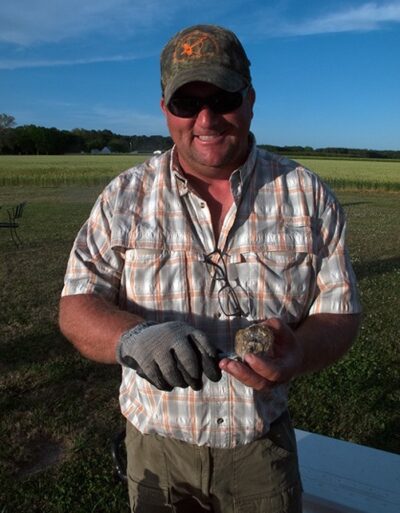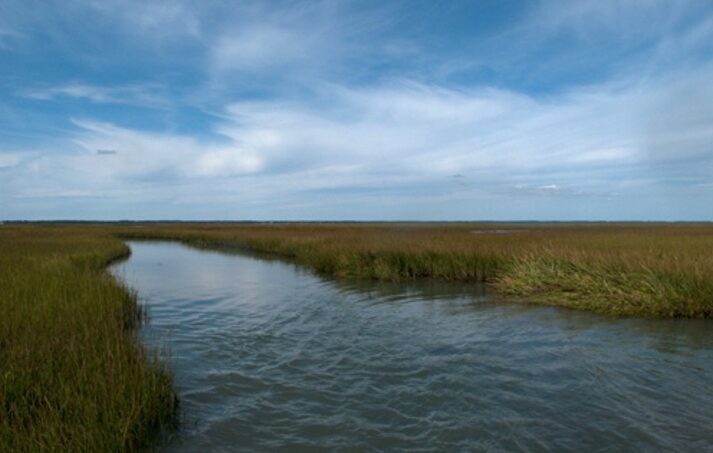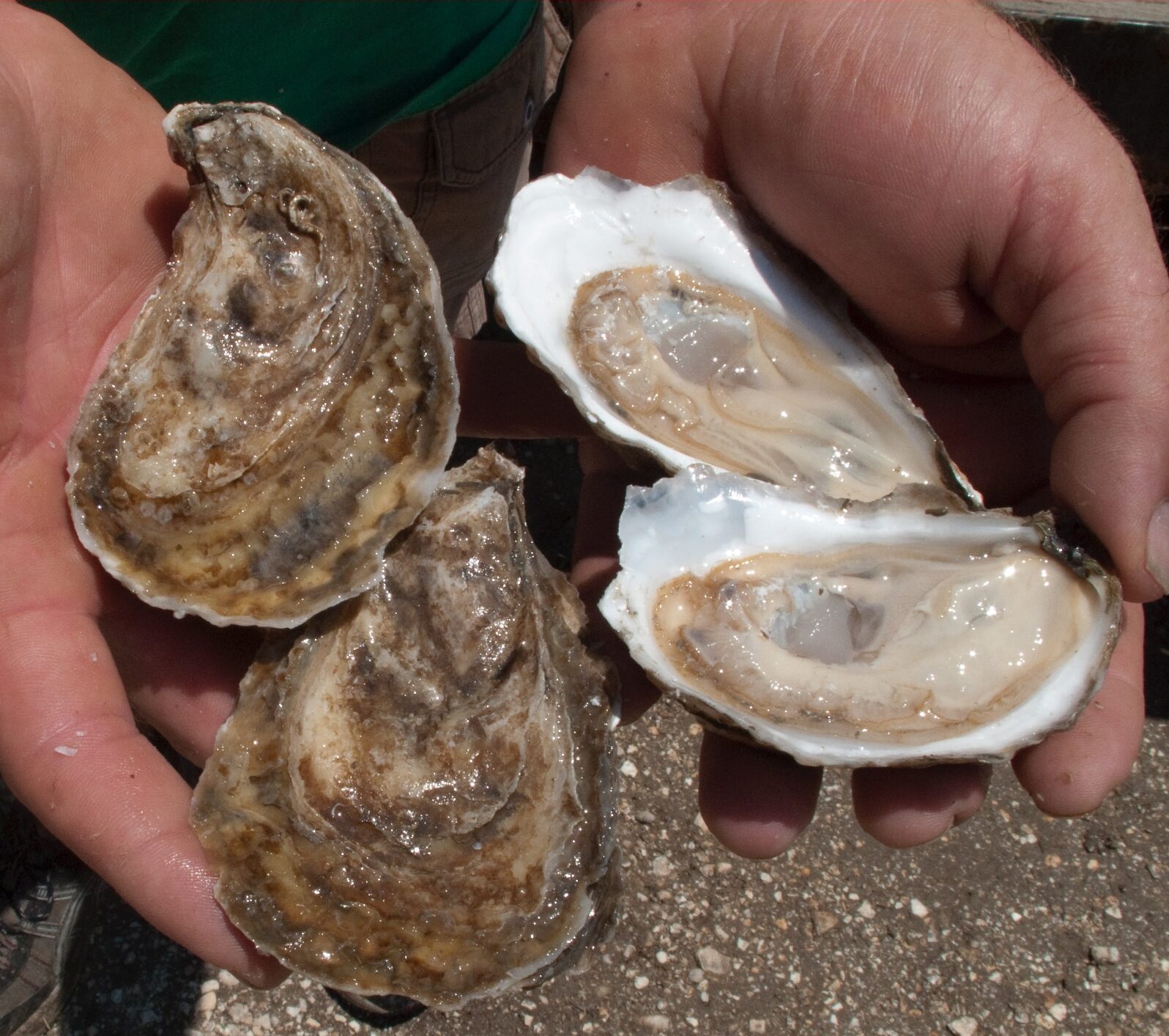The water in our creek and marsh on Virginia’s Eastern Shore grows colder by the day as a fading year slips away and the hopefulness of a new one approaches. Frost clings to browning marsh grasses, the tide runs winter clear, passing seabirds huddle on shoals and bars. Low tide. I wade out through the first thin skin of ice fractured and flaking away against my waders. Further from shore there is no ice, only glittering blue water twisting through ebbing channels. It’s the season at the end of an old year. Time to gather oysters for a new one—and a calling to reflect on why the oysters I harvest from my cages look the way they do. Appearances take time and they are no accident. I think back to summer.
I’m scrutinizing an oyster. Squinting, really. Maybe a sixteenth of an inch in length, the object—perfectly formed with a deep cup and rounded teardrop profile—balances neatly on oyster grower Tom Gallivan’s thumb and index finger. It is an oyster; it is a made thing, a farmed work subject to curation that begins with the eye and ends on the palate. It is an artisanal object devoured in its final “reading”—an act of complete and utter destruction. The cultured oyster is the craft we eat. The wild caught natural oyster, wrapped in spat, bent, twisted, enbarnacled, misshapen, is not. In an era when popular commodity culture embraces tropes of craft beers and artisan breads, handmade objects like yeast rolls, fritters, and oysters reveal important questions surrounding aesthetics, ephemerality, discernment, and marketplace in the production of identity and reputation.

Back in mid-July on the Eastern Shore, a long, narrow, sandy peninsula that separates the Atlantic Ocean and the Chesapeake Bay can be beautiful and miserable in the same moment. I am listening to Tom describe how he “makes” an oyster. It’s late afternoon, the day is hot, the overripe, marshy, saltwater scent of discarded oyster culls wafts from his shell pile, which towers a dozen feet high adjacent to his packing house and barn. In winters past, Tom’s kids sledded down the pile on make-shift seed-bag toboggans: “We toughen them up around here,” he says. “Kids or oysters,” I wonder?
Tom is taking a break from working on an outboard motor that has seized up. Streaming sweat and grime, he leans against the boat trailer, observing, “[An oyster] is a crafted product and it takes a lot of effort and there’s a lot of different ways to do it like any other craft.” He tells me, “People are carrying on about what a natural product it is and how beautiful the oysters are—and what they don’t realize is that when it gets to these little round marblely oysters”—he’s alluding to what some growers market as petites or pearls—“that’s the farthest thing from being a natural product. They shouldn’t be proclaiming it as that.” Tom concludes, “It does make a uniform round product, but it’s not an oyster in its natural state.”

Tom reminds me that the chefs we know tend to respond to cultured oysters as natural objects as opposed to the made things they are. And, here is the nub of the craft we eat: aesthetics is defined not by a philosophy of the beautiful but rather by a balance and proportion of being in the world. When we engage the craft we eat, whether elaborately constructed cakes or homemade pimento cheese on a biscuit, we are enmeshed in craft ecologies, craft terroir, and craft theater. The craft we eat, arguably the largest and most varied universe of made things, invokes registers of natural history, gastronomy, commerce, agriculture, and etiquette.
Tom Gallivan gives us a sense of the mechanics of production in crafting or shaping an oyster. “Spawning them in an artificial environment,” he begins, “[we] get oysters to be single oysters.” “Then they’re placed in a downweller and they’re gently washed. At that point, you might be partially shaping them but that’s not the intent. It’s just to keep them clean. Once they get them outside onto raw water and they’re in an upwelling system. After they get a little size on them—they show up and they’re one millimeter—you maybe run them a week or so. Maybe two weeks.” His production narrative gathers speed, “Then you really start to swirl them around and blast them a little bit more with a hose to break them up and impart a rounder shape on them. You place them out in bags once they get up to a size where they catch on a quarter inch mesh—or into a floating upweller system so we can grow them up a little bit more. Again, they’re blasted and washed and tumbled. The whole time you’re chipping the bill and imparting a shape to them. Then they go out into the [Chesapeake] Bay in bags. Once they hit that part, about once a week we actually shake them. We’re shaping that edge and they’re not getting elongated. They’re getting more round.” “We’re not letting them grow skinny and long,” he says, dismissing wild brush oysters that flourish along creek and channel shorelines, “because that’s a less desirable shape in the marketplace. It’s a characteristic that appears when you have them at high density in nature.”

“That’s how we make oysters,” Tom presses on.
“That’s how we make oysters,” Tom presses on, “We just handle them a lot and then at a certain point, too, we go through a culling process that’s all done by hand after all of that handling. They’re selected out by eye. Some of the ones that are less desirable in shape are tumbled down the machine again and have the bills beat on them and shaped once again. Sometimes we transfer them to a different location where they might grow slower or might grow faster. That environment might impart a little bit of shape on them. It’s a long process that involves a lot of handling. That’s how we make an oyster that’s acceptable to the market.”
When I think of cultured oysters I think of craft ecologies. Ecologies are organic systems of relations mapped by mutuality, interdependency, and environment. If an ecology is the system of interactions between organisms and their surroundings, a craft ecology is a network of relationships between people, objects, and processes that come together to constitute a particular universe of made things. The complexities of ordinary things are in constant negotiation. Craft ecologies quietly manifest ideologies of the everyday through the subtle operations of networks defined by folklorist Robert St. George as a “poetics of implication.”
Tom’s oysters reveal the underlying chains of habit, value, and assumption of the ideological construction of craft. Tom summarizes a labor-intensive collaborative process driven by opportunity and empathy for materials. “An oyster, even though we’ve cultured them” he emphasizes his word choice, “even though we’ve cultured them for a number of years now, from the standpoint of genetic homogeneity, you still are dealing with something that has drastic variations.” Tom stresses the seeming intractability of his medium (oysters) relative to a market-based desire for uniformity—not in flavor, but rather in appearance. Market is central to craft ecologies.

The craft we eat introduces questions of identity, local knowledge, and terroir–the taste of place. Terroir, observes culinary historian Amy B. Trubek, offers a means “for framing and explaining people’s relationship to the land, be it sensual, practical, or habitual.” Craft terroir frames our conversations around made things in their generative and consumed geographies, the particular attributes of place embodied and narrated through words, actions, and objects. We ingest and digest terroir; we curate, collect, and display craft terroir. In doing so, we imbue ourselves with the tastes and sensibilities of identity and authenticity. Our bodies literally absorb terroir and we translate its substance into narratives of place and experience, capturing a consciousness of association and belonging. Place alone, however, fails to translate the deeper associations that craft terroir projects about identity. That is the work of craft ecologies. Craft terroir is experience and emotion, embodiment and immediacy, custom and invention, destiny and storytelling. When we invoke craft terroir, we speak about ourselves.
Tom’s commentary goes to the heart of craft ecologies as the actions and interactions between maker, audience/client, and object. He positions his commentary around design: “You try and get your oysters as uniform as possible. It’s funny. You can put a box of oysters out that are big. You can put a box of oysters out that are small. But, if you put a box of oysters out that has big ones and small ones in it, the market is going to bitch about it. You’re going to get complaints.” when chefs put them on a plate, they want . . . everything to be exactly the same size.”
Tom’s conflation of process and culture in crafting an oyster speaks directly to a core characteristic of craft ecologies—the interaction of makers and media around desire, expectation, and market. The production process Tom describes parallels techniques in other oyster growing geographies. Oyster growers on the coast of Normandy, for example, use a rack-and-bag system that demands constant handling. The harvested bivalves are carried to packing houses where culling and finishing take place. There the oysters are washed, sorted, flushed with filtered seawater, and packed in rustic baskets lined with seaweed. Conveyed to market, the oysters, labeled by variation and locale, are displayed in open baskets—some plastic, some woven wicker.
Imperfectly crafted oysters are relegated to the status of ingredient. Tom explains, “If they are not properly handled, they’re of little value. So, that’s when they’re more suited to be something to send to a shucking house because your just worried about the meat yield at that point. You’re not worried about the aesthetic experience of having a beautiful oyster sitting there in a restaurant. You’re just worried about frying up some meats and having a little bit of size to them to do whatever recipe you’re trying to accomplish.”
Shucking oysters in packing houses is a form of skilled, routinized labor. There is regional variation in this work, but on the Eastern Shore of Virginia the process flows as follows. Runners wheel baskets of oysters into the shucking room and dump the contents onto worktables. The shuckers rhythmically reach into the pile in front of them, bang the bills on a spud, insert their knives, twist, cut, and deposit the oysters into a gallon can—at a rate of seven to ten oysters per minute. The oysters have to be whole without nicks, belly cuts, or blemishes. The work is repetitive handwork and the process defies mechanization. Generally, this occurs out of sight and the outcome is measured qualitatively and quantitatively as a commodity product.

All work requires some level of skill, but we tend to value labor in proportion to the complexity and dexterity of the skill required. This raises a fundamental question at the heart of craft theater. Consider raw bar oyster shucking in a restaurant or stand-alone venue as theater where the actors open oysters on the spot with the carefree nonchalance of practiced (and scarred) hands. This form of performance is less about the made thing and more about the consumption of enacted craft. The craft theater of raw bars is remarkably consistent across broad geographies—and it introduces a different equation to the connection between craft and place. The geographies and ecologies here are defined not by the coordinates of location, but rather by the coordinates of practice. I am mindful of the seamlessness of experience between the Bastille market in Paris, the quayside of Cancale, the street markets of New Orleans, and raw bars of Manhattan and Washington, DC. The locations are distinct and distant, the craft ecologies they entail, though, cohere around the display, application, and connoisseurship of ordinary practice.
In the days before the new year arrives, I look at the oysters in my basket and reflect on presentation. Craft theater inspires narratives of excess around skill, materials, acquisition, and occasion—or, in a word, spectacle. In the spectacle of “the craft we eat,” the oysters I’ll shuck and share on New Years Day are the set pieces of craft theater, a point where craft bleeds into art. If we look at how the ecological interactions (material, process, production, reception, aesthetics, occasion) invoke terroir and theater—we open our imaginations to the craft in everyday life. Lugging a basket of oysters through chilled water, my thoughts pivot toward the tangible pleasures of New Year on the half shell.
Bernard L. Herman, George B. Tindall Distinguished Professor of Southern Studies and Folklore at the University of North Carolina at Chapel Hill, works on the material cultures of everyday life and the ways in which people furnish, inhabit, communicate, and understand the worlds of things. His teaching and research cohere around teaching and public engagement and a deeply held belief that work of the arts and humanities finds its first calling in the public sphere. He also grows oysters on the Eastern Shore of Virginia, where he cultivates a “library” of fig varietals.

